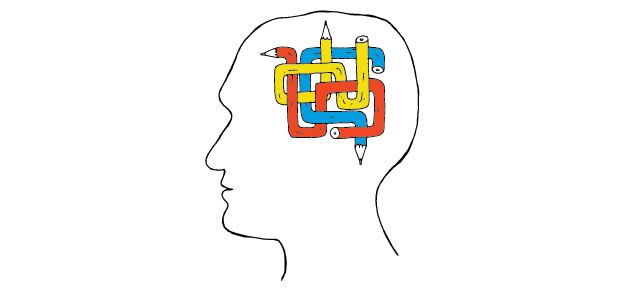During the 1980s, April Greinman was one of the first designers to use a Macintosh computer. She saw the computer as an ideal tool that would contribute to experimentation.
Ironically today, it is a question whether the invention of the computer and design software has negatively impacted the creative and research process. In fact, various factors have immobilized the design practice. Some critics argue that American schools are producing weak undergraduate designers. Effective designs depend on proper research, experimentation, collaboration, critiques, creativity and even teaching.
The design field is confused on how to advance its discipline as well as maintain, build and share knowledge.

Gadi Amit, president of NewDealDesign LLC., views thousands of portfolios a year. He claims he has noticed portfolios becoming weaker; showing two separate categories of skills and process work instead of integrating both. He articulates several assumptions.
Academic design programs have cloudy standards that are not constant with one another. Because of this, students have no real design process education. Many have an idea of “Design thinking,” but lack the knowledge of cultural, aesthetic, or form intelligence. Ultimately, fewer understand what design integration is. Most importantly, the key to all creative process, handsketching, is dying.
Sharon Poggohpohl believes that students primarily in undergraduate schools don’t know what research is. This may be in part of her argument that undergraduates are prepared for professional practice, while higher degrees come with the responsibility of research and teaching.
Good research is certainly not looking through trade magazines, asking people for their opinions on your design, nor fooling around with design forms to achieve better results. True research contributes to a discipline’s development. Instructor Micah Barrett at the Rhode Island School of Design also agrees that influence from trade magazines and internet blogs is apt. It transforms designers into decorators, lacking engagement in the story they’re telling.

Jeanne Verdoux, teaches incoming freshmen Process and Skills at Parsons New School for Design in New York. She agrees that the computer impacts process and that students must know what they are doing before they get on the computer. Development before production is key so she requests proof of process for course assignments. Her method includes:
- Research and image references
- Sketches and initial visual concept
- Development of concept and production
- Revisions
Outside the school setting, working designers are constrained by time and finances. I have witnessed how easy it is for designers to skip some methods and/or transfer them to the computer. For instance, rough compositions are quickly created on Illustrator, allowing quicker changes later by shifting design forms and elements to the client’s request. Deadlines are of importance for firms, but I do think that with a proper method, time and quality can merge.

For instance, Matt Cooke developed a systematic approach to design when working for the World Cancer Research Fund. The organization wanted to alert the public of the link between obesity and cancer. Required to make a leaflet, Cooke developed a design methodology by researching several theorists and practitioners.
He drafted his own methodology composed of all their ideas, also allowing for changes that could be modified to his convenience. He claims that the benefit of his systematic approach is that it is a clear, quick and progressive plan that accounts for every stage in the design process. It also enhances creativity because it allowed for his team to interpret the findings in imaginative ways. Although the leaflet was successful, Cooke admits that the strengths of methodologies continually must feed back on suggestions for improvement.
This realization is another factor that designers fail to ignore. Ego is a big problem designers face when it comes down to their work. It discourages a designer in considering strategies to improve.
Instead, they fall victim to what Poggehnpohl calls “tacit knowledge,” a term that explains why some designers can not provide a clear explanation to their work. Tacit knowledge is related to Paul Rand’s definition of intuition, which is a “flash of insight conditioned by experience, culture, and imagination” (Bennett 15).
Poggehnpohl encourages explicit knowledge, which doesn’t necessarily rule out tacit, but requires a foundation in theory, principles, methods, and/or teamwork to provide developmental design. The generation of theory, development, testing and creating tools is an explicit activity based on analysis and trial and error. Instead, disciplinary development is rejected according to several factors:
- There is little value placed on creativity
- The specifity and messiness of the design practice
- Research is seen as dry and unimaginative
- Designers are isolating themselves from one another
- There is disconnected information
- Traditional craft education is neglecting contemporary challenges
- The location of art schools and universities
- Designers are not interacting with other disciplines because they are intimidated by their language (such as science)
- Varieties of research are unknown
Poggehnpohl and Amit both agree that universities are a muddled mess. However, I believe that it is reinstated in Poggehnpohl’s factors that design is a messy yet specific practice. There is no defined step-by-step method to creating a pamphlet, poster, or book.
I don’t think design can be an algebraic solution because the possibilities are always endless.
Thomas Ockerse from the Rhode Island School of Design believes that the design process is not mechanical. Like life itself, it is a living, dynamic, and changing human experience. However, designers can positively use their intuition to determine what proper steps they see fit for a certain design.
Ultimately, designers need to be able to justify themselves and have the ability to argue, question and discover. Not being able to do so is just an act of faith.

Nevertheless, quantifiable research, or justifying why particular designs are produced should be practiced with caution (especially in marketing.) As Poggehnpohl mentioned, asking others for their opinions can be harmful, and in the case of consumers, should always be avoided.
Debbie Millman explains that qualitative and quantitative research has a bad reputation because consumers are uncomfortable with change. Consultants and anthropologists do believe that research is not the problem, but how it is used incorrectly.
Research should not interfere with creativity and should give designers inspiration and focus. As a result, a consumer should never be asked how to improve a design.
I believe there is no wrong way, as long as a designer has truly committed themselves to improvement by utilizing skills approved by educational standards. Although designers can practice relevant steps to complete a design, the option of trial and error never goes wrong.
Mistakes always allow for improvement and reconsideration. Sometimes, even good mistakes happen and open new avenues.

Ockerse’s opinion hits the nail on the head with his interview statement, “personally I place SEARCH (to discover what is not known) far above RESEARCH (to collect what is known.)”
After all, design research should be flexible and allow trial and error for results. Revealing the unknown opens new doors. It’s when designers become comfortable and don’t question their methods that the advancement of design becomes stuck.
Designers must remove themselves from the computer, and explore outside their boundaries and norms. Critiques and collaboration with other disciplines is linked to why we talk, and ultimately communicate ideas. Design, best known for communication, should always reflect those actions.
Related Topics
Top